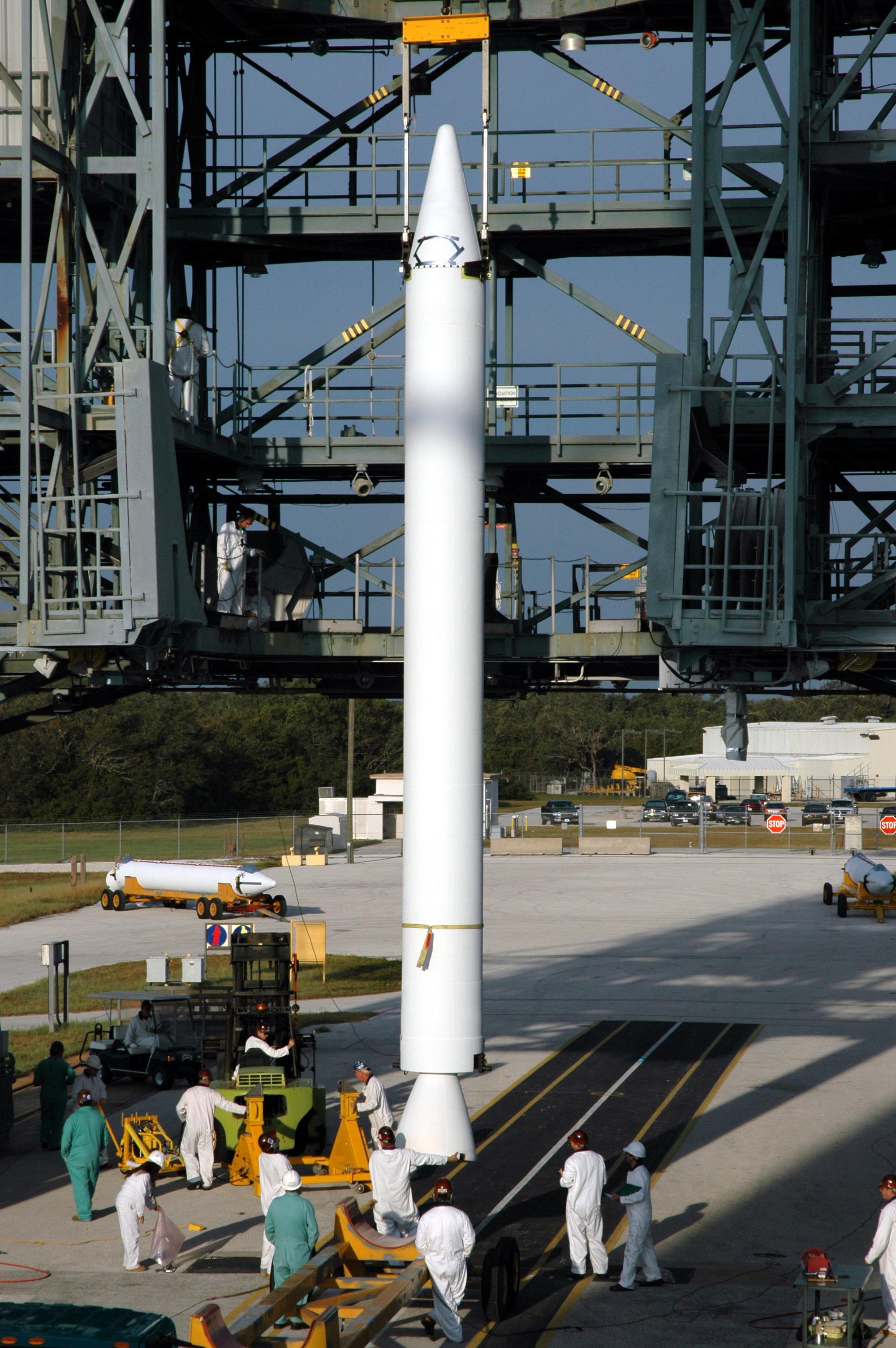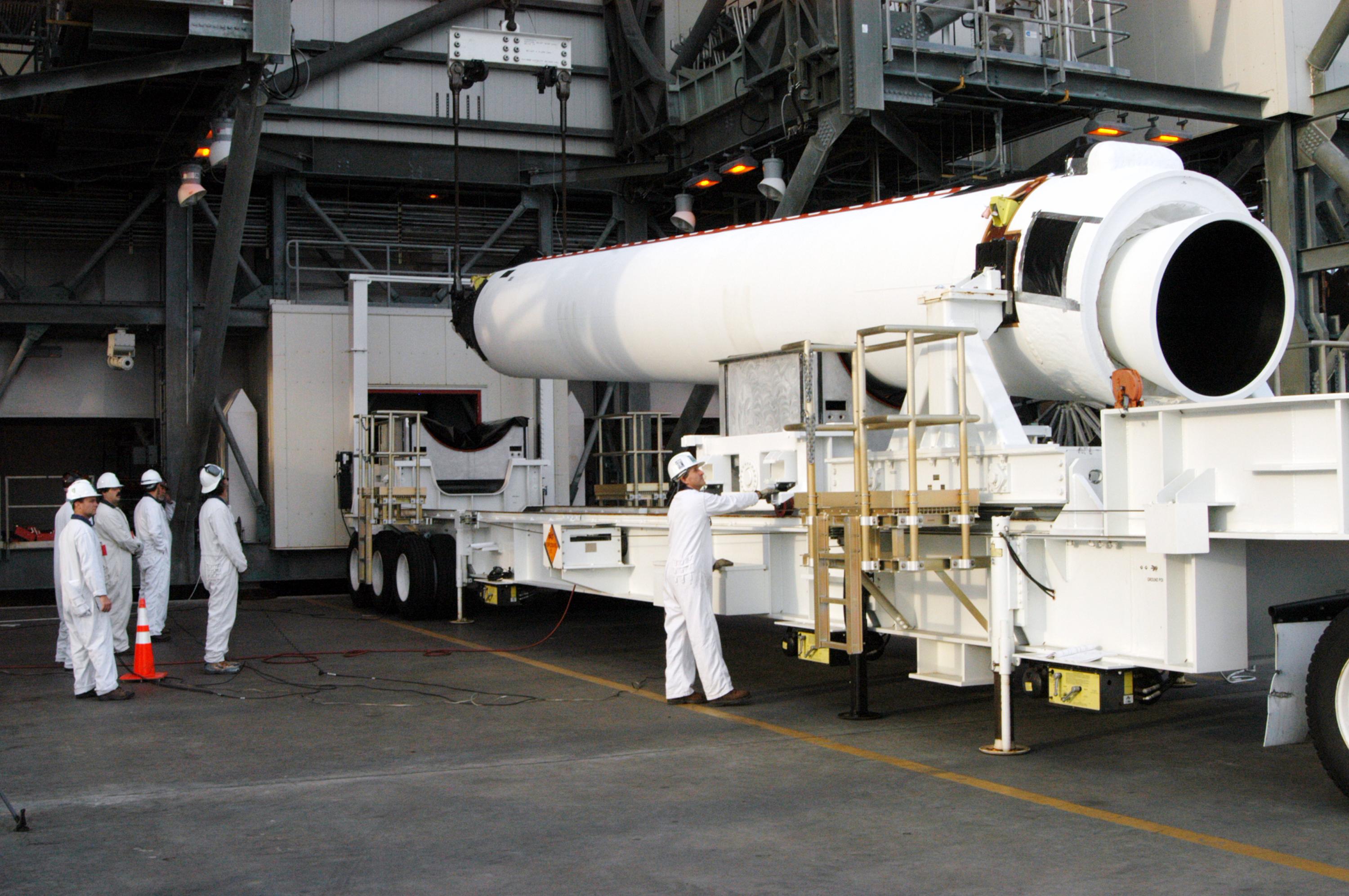GEM 46 on:
[Wikipedia]
[Google]
[Amazon]
The Graphite-Epoxy Motor (GEM) is a family of
 The GEM 40 was a solid rocket motor developed for the 7000-series
The GEM 40 was a solid rocket motor developed for the 7000-series

File:GEM 46 Booster of an Delta II 7925H rocket.jpg, alt=GEM 46 solid rocket booster is seen in the integration facility., A GEM 46 motor prior to mating to a Delta II 7925H
File:Rocket0722 09.jpg, Technicians prepare a GEM 46 booster
File:GEM under tow prior to OCO-2 mission (KSC-2014-2126).jpg, GEM 40 booster is towed to the integration facility
File:Delta IV Medium 4,2+ launch with GOES-N.jpg, alt=A Delta IV rocket blasts off with the help of GEM 60 solid rocket motors., A Delta IV M+ (4,2) lifts off with 2 GEM 60 boosters
File:Delta II Heavy ignition with GLAST.jpg, alt=A Delta II rocket ignites its engines, including 9 GEM 46 solid rockets., A Delta II 7920H ignites 9 GEM 46 boosters
File:STP-3 Mission (211107-X-KD758-1002).jpg, An Atlas V 541 lifts off with 4 GEM 63 boosters
solid rocket booster
A solid rocket booster (SRB) is a large solid propellant motor used to provide thrust in spacecraft launches from initial launch through the first ascent. Many launch vehicles, including the Atlas V, SLS and space shuttle, have used SRBs to giv ...
s first developed in the late 1980s and used from 1990 to the present day. GEM motors are manufactured with carbon-fibre-reinforced polymer casings and a fuel consisting of HTPB-bound ammonium perchlorate composite propellant. GEM is currently produced by Northrop Grumman Space Systems. GEM boosters were previously used on the Delta II
Delta II was an expendable launch system, originally designed and built by McDonnell Douglas. Delta II was part of the Delta rocket family and entered service in 1989. Delta II vehicles included the Delta 6000, and the two later Delta 7000 v ...
, Delta III
Delta III was an expendable launch vehicle made by Boeing. The vehicle was developed from the highly-successful Delta II to help meet the launch demand of larger satellites. The first Delta III launch was on August 26, 1998. Of its three flights ...
, and Delta IV
Delta IV is a group of five expendable launch systems in the Delta rocket family introduced in the early 2000s. Originally designed by Boeing's Defense, Space and Security division for the Evolved Expendable Launch Vehicle (EELV) program, t ...
launch vehicle
A launch vehicle or carrier rocket is a rocket designed to carry a payload (spacecraft or satellites) from the Earth's surface to outer space. Most launch vehicles operate from a launch pads, supported by a launch control center and syste ...
s, and are currently used on the Atlas V
Atlas V is an expendable launch system and the fifth major version in the Atlas launch vehicle family. It was originally designed by Lockheed Martin, now being operated by United Launch Alliance (ULA), a joint venture between Lockheed Marti ...
. A new variant, the GEM 63XL, is slated to fly as part of the Vulcan Centaur
Vulcan Centaur is a two-stage-to-orbit, heavy-lift launch vehicle that is under development by the United Launch Alliance (ULA) since 2014 with an initial flight expected in early 2023. It is principally designed to meet launch demands for th ...
launch vehicle no earlier than the 1st quarter of 2023.
Variants
Active
GEM 63
The GEM 63 was developed byOrbital ATK
Northrop Grumman Innovation Systems (NGIS) was a sector (business segment) of Northrop Grumman from 2018 through 2019. It was formed from Orbital ATK Inc. a company which resulted from the merger of Orbital Sciences Corporation and parts of Alli ...
as a low-cost drop-in replacement for the Aerojet Rocketdyne
Aerojet Rocketdyne is an American manufacturer of rocket, hypersonic, and electric propulsive systems for space, defense, civil and commercial applications. Headquartered in Sacramento, California, the company is owned by Aerojet Rocketdyne Hold ...
AJ-60A solid rocket booster used on the Atlas V. Its overall dimensions are very similar to that of the motor it replaces. The Atlas V first flew with the GEM 63 in 2020 on the NROL-101 launch. The booster offers higher performance at about half the cost of the AJ-60A boosters formerly used on the Atlas V. The change to GEM motors also allows a degree of commonality between the Atlas V and Delta IV, which are both produced and marketed by the United Launch Alliance
United Launch Alliance (ULA), legally United Launch Alliance, LLC, is an American spacecraft launch service provider that manufactures and operates a number of rocket vehicles that are capable of launching spacecraft into orbits around Earth, ...
.
GEM 63XL
The GEM 63XL, developed by Northrop Grumman, is an extended version of the GEM 63, about 73 inches (185 cm) longer than its predecessor. First fired in 2020, it will be used on the Vulcan launch vehicle beginning no earlier than 2022. Up to 6 of the boosters will be mounted on a single Vulcan core, depending on customer needs. A variant equipped with athrust-vectoring
Thrust vectoring, also known as thrust vector control (TVC), is the ability of an aircraft, rocket, or other vehicle to manipulate the direction of the thrust from its engine(s) or motor(s) to control the attitude or angular velocity of the ve ...
nozzle, the GEM 63XLT, was under development for the cancelled OmegA
Omega (; capital: Ω, lowercase: ω; Ancient Greek ὦ, later ὦ μέγα, Modern Greek ωμέγα) is the twenty-fourth and final letter in the Greek alphabet. In the Greek numeric system/ isopsephy ( gematria), it has a value of 800. Th ...
launch vehicle.
Retired
GEM 40
 The GEM 40 was a solid rocket motor developed for the 7000-series
The GEM 40 was a solid rocket motor developed for the 7000-series Delta II
Delta II was an expendable launch system, originally designed and built by McDonnell Douglas. Delta II was part of the Delta rocket family and entered service in 1989. Delta II vehicles included the Delta 6000, and the two later Delta 7000 v ...
launch vehicle beginning in 1987 by Hercules
Hercules (, ) is the Roman equivalent of the Greek divine hero Heracles, son of Jupiter and the mortal Alcmena. In classical mythology, Hercules is famous for his strength and for his numerous far-ranging adventures.
The Romans adapted th ...
. Its first flight took place in 1990 on the USA-66 mission, when 9 boosters were used on a Delta II 7925 launcher. The use of composite materials allowed for casings lighter than the steel casings of the Castor 4 SRMs they replaced. The reduction in weight was used to extend the GEM 40 by 1,8 meter (6 feet) compared to the Castor 4 used on 6000-series Delta II. Delta II vehicles could be configured with three, four, or nine GEM 40 boosters. When using three or four boosters, all GEM 40s were ignited on the ground. On nine-booster Delta II, six were ignited on the ground; the remaining three were ignited in flight after burnout of the first six. A variant with a thrust-vectoring
Thrust vectoring, also known as thrust vector control (TVC), is the ability of an aircraft, rocket, or other vehicle to manipulate the direction of the thrust from its engine(s) or motor(s) to control the attitude or angular velocity of the ve ...
nozzle, the GEM 40VN, was developed for the Ground-based Midcourse Defence anti-ballistic missile program.
= Failures
= On 5 August, 1995, an air-lit GEM 40 failed to separate from a Delta II 7925 carryingKoreasat 1
Koreasat 1 was a South Korean communications satellite launched by a Delta II rocket from Cape Canaveral Air Force Station, Florida, United States. Owned by KT Corporation.
One of the boosters of the Delta II rocket failed to separate from the fir ...
. The excess mass of the booster resulted in the satellite reaching a lower orbit than intended. The satellite was able to correct for the error using on-board propellant.
On 17 January, 1997, a Delta II (Delta 241) exploded due to a catastrophic failure in a GEM 40. The failure triggered the launch vehicle's self-destruct
A self-destruct is a mechanism that can cause an object to destroy itself or render itself inoperable after a predefined set of circumstances has occurred.
Self-destruct mechanisms are typically found on devices and systems where malfunction could ...
function 13 seconds after ignition. An Air Force investigation determined that the motor's casing had been damaged prior to launch, causing the case to split open soon after ignition.
GEM 46
The GEM 46 was a solid rocket motor originally developed forDelta III
Delta III was an expendable launch vehicle made by Boeing. The vehicle was developed from the highly-successful Delta II to help meet the launch demand of larger satellites. The first Delta III launch was on August 26, 1998. Of its three flights ...
by Alliant Techsystems
Alliant Techsystems Inc. (ATK) was an American aerospace, defense, and sporting goods company with its headquarters in Arlington County, Virginia, in the United States. The company operated in 22 states, Puerto Rico, and other countries. AT ...
. This solid motor variant included thrust vector control (TVC) to help steer the vehicle. After the discontinuation of the Delta III, GEM 46 motors (without TVC) were used on the Delta II to create the Delta II Heavy, which could only be launched from a modified pad at Cape Canaveral Air Force Station
Cape Canaveral Space Force Station (CCSFS) is an installation of the United States Space Force's Space Launch Delta 45, located on Cape Canaveral in Brevard County, Florida.
Headquartered at the nearby Patrick Space Force Base, the stat ...
, SLC-17B. Both Delta III and Delta II Heavy used nine GEM 46s, with six ignited on the ground and three air-lit.
= Failures
= On 27 August, 1998, the GEM 46 boosters on the first Delta III, carrying the Galaxy 10 satellite, depleted their hydraulic fluid used to control the thrust-vectoring nozzle. This was due to guidance issues with the rest of the rocket, which forced the solid rocket motors to make rapid adjustments to compensate, using up the supply of hydraulic fluid before burnout. The nozzles were then stuck in a position that turned the rocket over, triggering the vehicle's self-destruct function 70 seconds after ignition.
GEM 60
The GEM 60 was a solid motor used on theDelta IV
Delta IV is a group of five expendable launch systems in the Delta rocket family introduced in the early 2000s. Originally designed by Boeing's Defense, Space and Security division for the Evolved Expendable Launch Vehicle (EELV) program, t ...
family of launch vehicles, used with and without thrust vector control. Developed for the EELV program, its first flight was on 20 November 2002, boosting the first launch of the Delta IV. Delta IV Medium+ launchers were built with either two or four GEM 60. The added performance from the solid rocket motors allowed variants of the Delta IV Medium+ to accommodate a larger second stage. The motor was retired in 2019 after the final Delta IV Medium launch. Throughout its lifetime, 64 GEM 60 boosters were flown; there were no failures.
Version comparison
Gallery
See also
*Solid rocket
A solid-propellant rocket or solid rocket is a rocket with a rocket engine that uses solid propellants (fuel/oxidizer). The earliest rockets were solid-fuel rockets powered by gunpowder; they were used in warfare by the Arabs, Chinese, Persia ...
* Spacecraft propulsion
Spacecraft propulsion is any method used to accelerate spacecraft and artificial satellites. In-space propulsion exclusively deals with propulsion systems used in the vacuum of space and should not be confused with space launch or atmospheric ...
* Composite overwrapped pressure vessel
References
{{Rocket engines Solid-fuel rockets